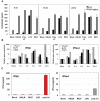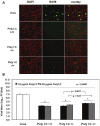Protective role of Toll-like Receptor 3-induced type I interferon in murine coronavirus infection of macrophages
- PMID: 22754655
- PMCID: PMC3386628
- DOI: 10.3390/v4050901
Protective role of Toll-like Receptor 3-induced type I interferon in murine coronavirus infection of macrophages
Abstract
Toll-like Receptors (TLRs) sense viral infections and induce production of type I interferons (IFNs), other cytokines, and chemokines. Viral recognition by TLRs and other pattern recognition receptors (PRRs) has been proven to be cell-type specific. Triggering of TLRs with selected ligands can be beneficial against some viral infections. Macrophages are antigen-presenting cells that express TLRs and have a key role in the innate and adaptive immunity against viruses. Coronaviruses (CoVs) are single-stranded, positive-sense RNA viruses that cause acute and chronic infections and can productively infect macrophages. Investigation of the interplay between CoVs and PRRs is in its infancy. We assessed the effect of triggering TLR2, TLR3, TLR4, and TLR7 with selected ligands on the susceptibility of the J774A.1 macrophage cell line to infection with murine coronavirus (mouse hepatitis virus, [MHV]). Stimulation of TLR2, TLR4, or TLR7 did not affect MHV production. In contrast, pre-stimulation of TLR3 with polyinosinic-polycytidylic acid (poly I:C) hindered MHV infection through induction of IFN-β in macrophages. We demonstrate that activation of TLR3 with the synthetic ligand poly I:C mediates antiviral immunity that diminishes (MHV-A59) or suppresses (MHV-JHM, MHV-3) virus production in macrophages.
Keywords: TLR; antiviral state; macrophage; murine coronavirus; poly I:C; type I IFN.
Figures








Similar articles
-
A role for microRNA-155 modulation in the anti-HIV-1 effects of Toll-like receptor 3 stimulation in macrophages.PLoS Pathog. 2012 Sep;8(9):e1002937. doi: 10.1371/journal.ppat.1002937. Epub 2012 Sep 20. PLoS Pathog. 2012. PMID: 23028330 Free PMC article.
-
Murine coronavirus mouse hepatitis virus is recognized by MDA5 and induces type I interferon in brain macrophages/microglia.J Virol. 2008 Oct;82(20):9829-38. doi: 10.1128/JVI.01199-08. Epub 2008 Jul 30. J Virol. 2008. PMID: 18667505 Free PMC article.
-
Selective Packaging in Murine Coronavirus Promotes Virulence by Limiting Type I Interferon Responses.mBio. 2018 May 1;9(3):e00272-18. doi: 10.1128/mBio.00272-18. mBio. 2018. PMID: 29717007 Free PMC article.
-
Antiviral signaling through pattern recognition receptors.J Biochem. 2007 Feb;141(2):137-45. doi: 10.1093/jb/mvm032. Epub 2006 Dec 26. J Biochem. 2007. PMID: 17190786 Review.
-
Human Toll-like receptor-dependent induction of interferons in protective immunity to viruses.Immunol Rev. 2007 Dec;220(1):225-36. doi: 10.1111/j.1600-065X.2007.00564.x. Immunol Rev. 2007. PMID: 17979850 Free PMC article. Review.
Cited by
-
Potential Antiviral Immune Response Against COVID-19: Lessons Learned from SARS-CoV.Adv Exp Med Biol. 2021;1318:149-167. doi: 10.1007/978-3-030-63761-3_9. Adv Exp Med Biol. 2021. PMID: 33973177
-
SARS-CoV-2 Nsp5 Activates NF-κB Pathway by Upregulating SUMOylation of MAVS.Front Immunol. 2021 Nov 10;12:750969. doi: 10.3389/fimmu.2021.750969. eCollection 2021. Front Immunol. 2021. PMID: 34858407 Free PMC article.
-
Vitamin D3 Attenuates Viral-Induced Inflammation and Fibrotic Responses in Bronchial Smooth Muscle Cells.Front Immunol. 2021 Aug 26;12:715848. doi: 10.3389/fimmu.2021.715848. eCollection 2021. Front Immunol. 2021. PMID: 34512638 Free PMC article.
-
Canine Coronavirus Infection Modulates the Biogenesis and Composition of Cell-Derived Extracellular Vesicles.Biomedicines. 2023 Mar 21;11(3):976. doi: 10.3390/biomedicines11030976. Biomedicines. 2023. PMID: 36979955 Free PMC article.
-
VAX014 Activates Tumor-Intrinsic STING and RIG-I to Promote the Development of Antitumor Immunity.Mol Cancer Ther. 2025 Apr 2;24(4):587-604. doi: 10.1158/1535-7163.MCT-24-0509. Mol Cancer Ther. 2025. PMID: 39868467 Free PMC article.
References
Publication types
MeSH terms
Substances
Grants and funding
LinkOut - more resources
Full Text Sources
Other Literature Sources

